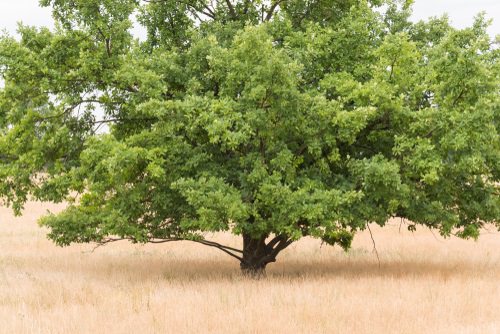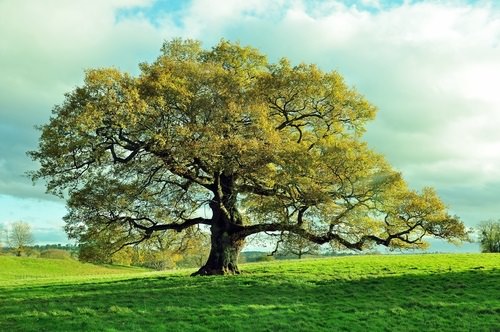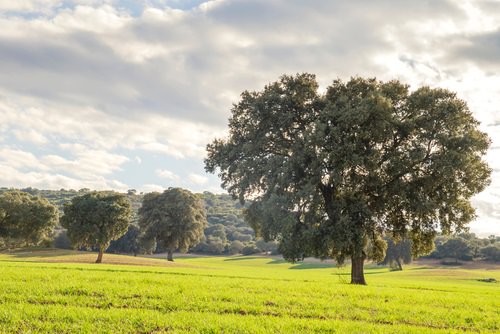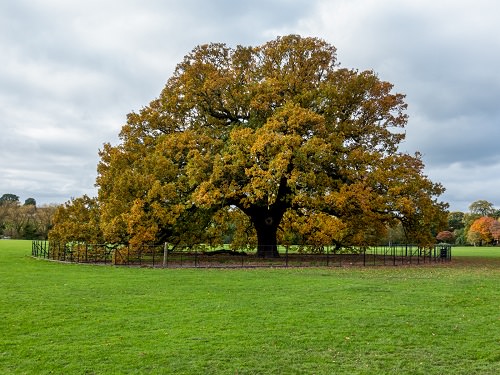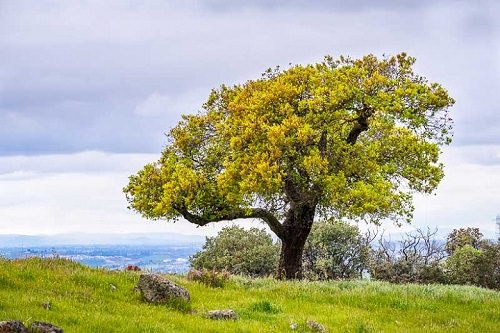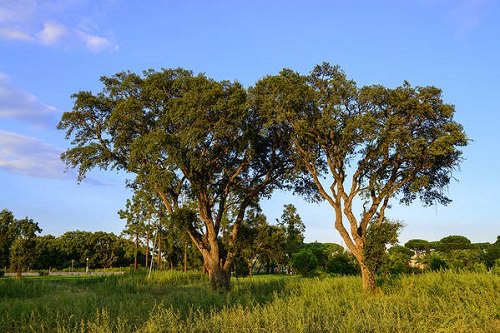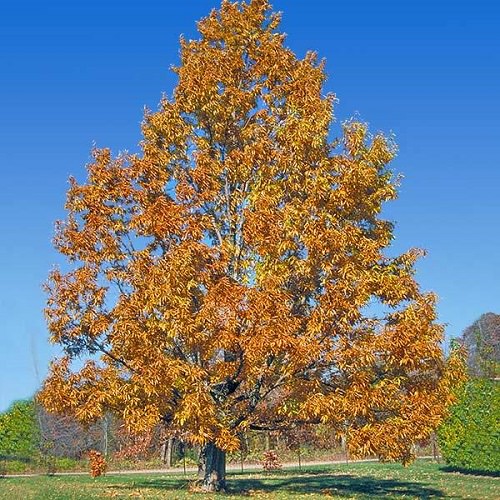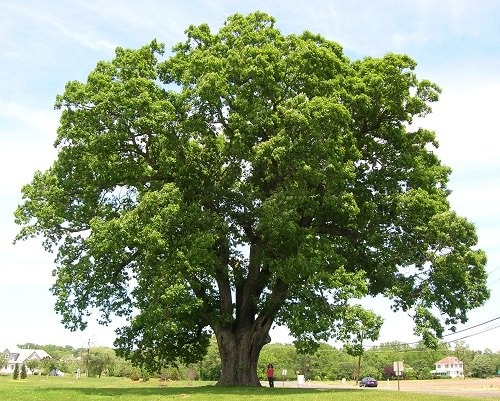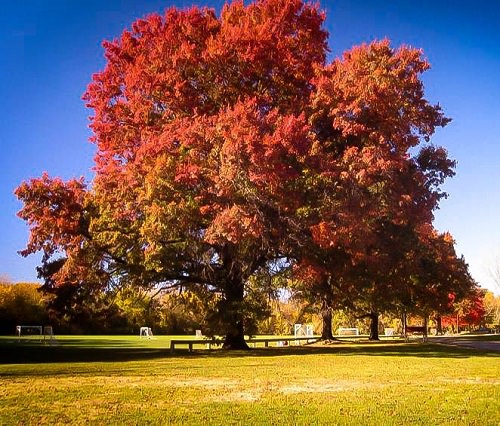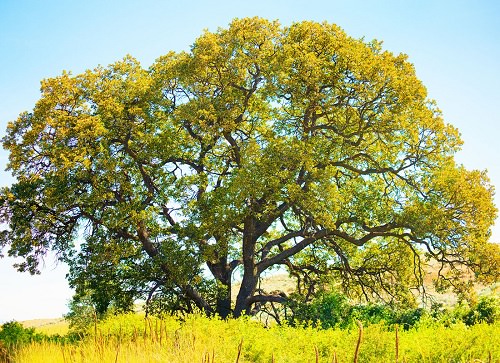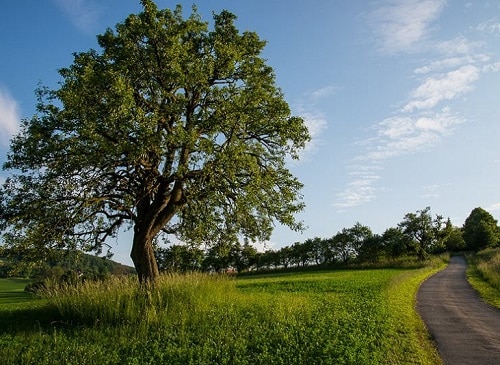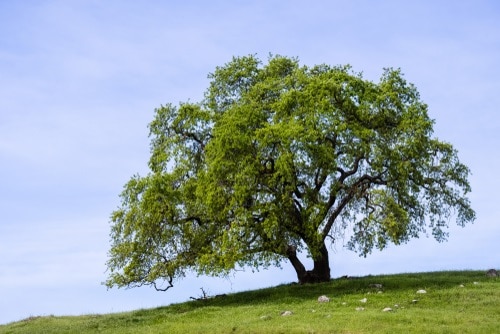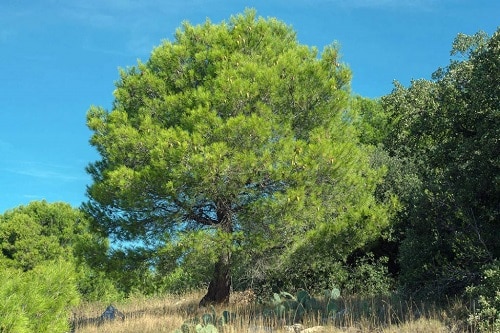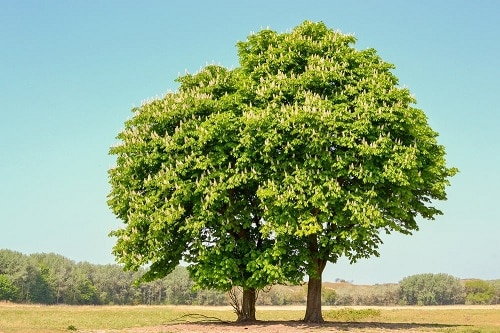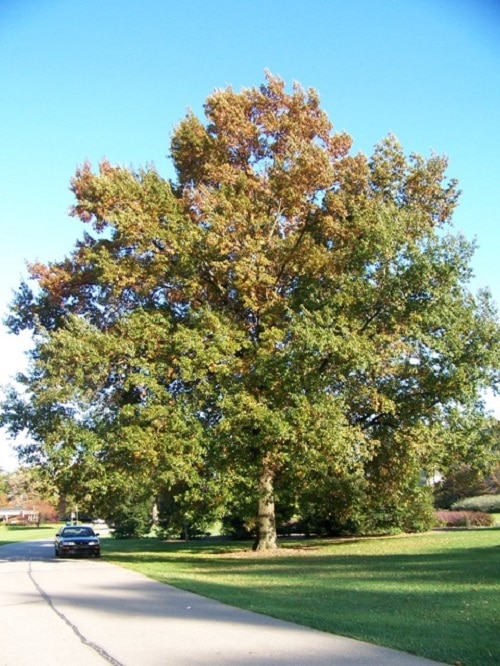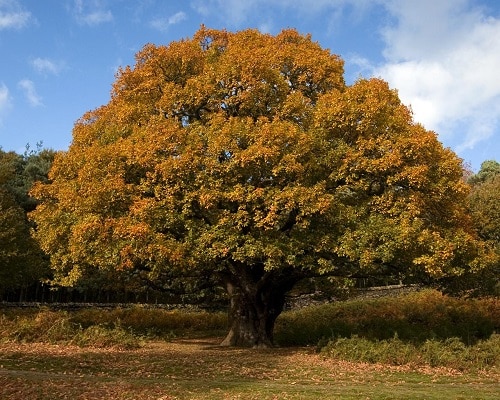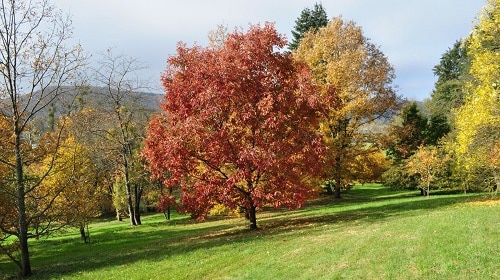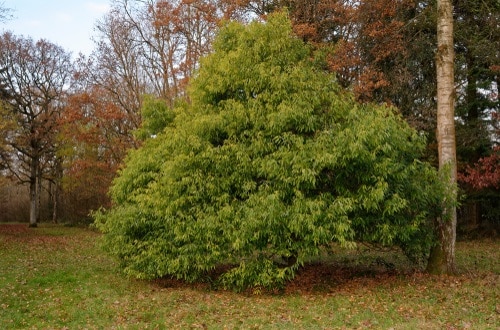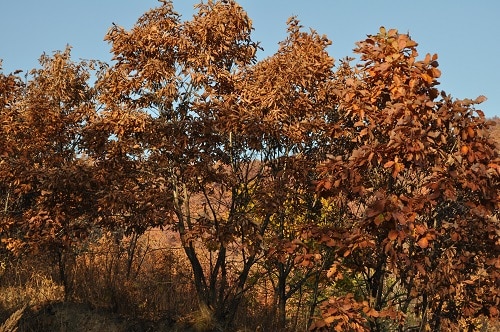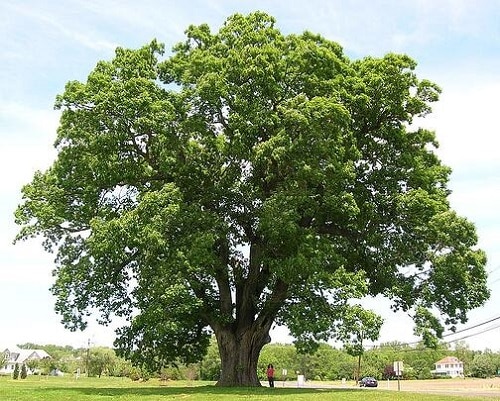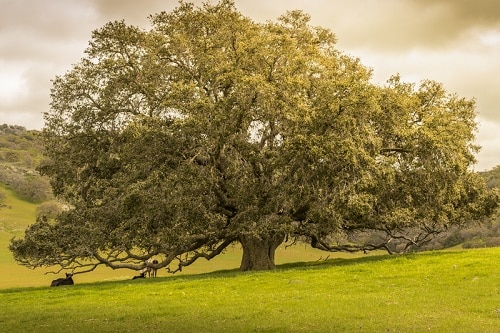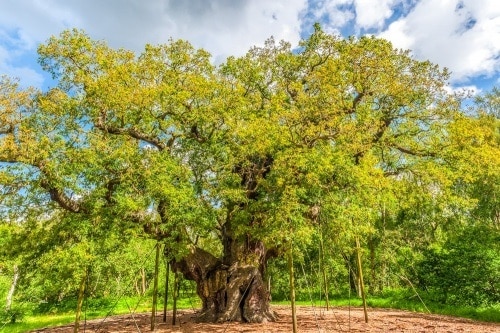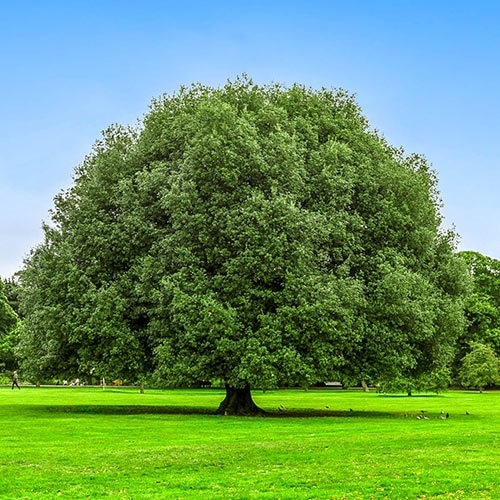Are you searching for a perfect tree addition to your landscape? Have a look at the different Types of Oak Trees that you can grow with ease!
Native to the northern hemisphere, Oak includes both evergreen and deciduous species. This national tree of Germany, the United States, and the United Kingdom is also known to represent strength and endurance. Culturally, the oak was considered to be sacred by the Celts. In fact, the name of the Celtic priests, Druid, is derived from the words of knowledge and oak. Now that you know about it, let’s have a look at the different Types of Oak Trees.
Check out different types of spruce trees here
Types of Oak Trees
1. Bur Oak
Botanical Name: Quercus macrocarpa
USDA Zone: 4-8
Appearance: The trees have leaves that are fiddle-shaped, green, and may look like a crown with the broad round tips looks like teeth than lobes. It grows up to a height of 70-80 feet.
Its monstrous trunk and bark help it exist in an extremely wide variety of soil – from wet bottomlands to dry uplands. It also provides food to squirrels, thick shade, and is impervious to air pollution and heat.
2. Southern Live Oak
Botanical Name: Quercus virginiana
USDA Zones: 6-9
Appearance: The oval-shaped leaves grow up to a length of 5-6 inches, while the tree grows up to a height of 50-80 feet on reaching maturity.
Southern Live Oak is one of the biggest trees, giving enormous spaces of huge, welcoming shade. It can have a spread of upto 60 to 120 feet! It is one of the best Types of Oak Trees you can grow.
3. Sessile Oak
Botanical Name: Quercus petraea
USDA Zones: 5-8
Appearance: The Sessile oak leaves are shallow lobed with a long leaf stalk. The huge deciduous tree can grow up to 65-130 feet in height.
Less renowned than English oak, yet no less adored, the Sessile Oak towers in the forested areas. Squirrels, jays, and badgers love its seeds, and caterpillars eat its leaves.
4. White Oak
Botanical Name: Quercus alba
USDA Zones: 3-9
Appearance: White oak leaves grow up to 5-9 inches long with short petioles, and 7-9 rounded lobes. The tree becomes 50-80 feet tall at maturity.
The White Oak is a huge, solid, forcing example. It has a short, stocky trunk with enormous horizontal limbs. The wide-spreading branches structure an upstanding, wide crown.
5. English Oak
Botanical Name: Quercus robur
USDA Zones: 5-8
Appearance: The English oak leaves are sinuate, with 4-7 rounded lobes, and have very short petioles. They grow up to a height of 50-60 feet.
The English Oak (Quercus robur) is a dignified tree most popular for being essential for the timberlands and landscapes of England. It is a huge species that are more commonly found in open settings like parks.
6. Northern Red Oak
Botanical Name: Quercus rubra
USDA Zones: 3-8
Appearance: Deeply sinuate to lobed leaves with tapered lobed ends. The northern red oak grows to a height of 60–75 feet at maturity.
The Red Oak, considered an overhanging sentinel tree, has a solid trunk structure, striking gray bark, and excellent red fall foliage with acorns valued by wildlife.
7. Holly Oak
Botanical Name: Quercus ilex
USDA Zones: 4-10
Appearance: The leaves of this not-too-tall tree grow naturally in a pyramidal shape and respond well to pruning. The tree can grow up to a height of 40-70 feet.
This evergreen oak is local to the Mediterranean area. It derives its name from holm, which is the ancient name for holly. This tree is not difficult to grow and care for.
8. Swamp Spanish Oak
Botanical Name: Quercus palustris
USDA Zones: 4-8
Appearance: Dark green shiny leaves with deep U-shaped lobes and stately pyramidal outline makes this tree distinct. These stunning leaves turn into a striking red color in autumn. It grows to a height of 60-70 feet at maturity.
Swamp Spanish Oak or Pin Oak is local to the United States and is one of the more fast-growing Red Oaks. It has a more thin, smooth appearance than certain oaks.
9. Plug Oak
Botanical Name: Quercus suber
USDA Zones: 6-10
Appearance: The leaves are 4-7 cm long with spiny-ended lobes and margins. This species grows up to a height of 60-65 feet.
It is a moderate growing tree with some survive as long as 250 years in age. Today it is most generally known for its utilization in wine bottle plugs.
10. Water Oak
Botanical Name: Quercus nigra
USDA Zones: 8-9
Appearance: The leaves vary from being either rounded to entirely three-lobed with numerous bristle tips. This deciduous reaches a height of 60-80 feet in height.
Water Oaks are local to North America and found across the American South. You can grow it as road plants or essential overhanging trees, and expect it to endure for 30 to 50 years.
11. Coast Live Oak
Botanical Name: Quercus agrifolia
USDA Zones: 7-11
Appearance: The dark green, oval-shaped leaves can grow up to 5-7 cm in length with a spiny-toothed margin. This drought-resistant evergreen can range in height from 20-80 feet.
The Coast Live Oak is an enormous tree local to the Pacific Coast of California and is a significant tree in California. This tree’s bark is very smooth when it’s young.
12. Chinkapin Oak
Botanical Name: Quercus muehlenbergii
USDA Zones: 5-9
Appearance: The oblong-lanceolate leaves can grow up to 5-7 inches in length. It changes color in the fall from yellow to orange-brown to brown. This tree can grow up to a height of 40-50 feet and spread out 50-60 feet at maturity.
Chinkapin Oak is an individual from the white oak family with chestnut-type leaves. In contrast to most White Oaks, Chinkapin Oak is tolerant to salty soil.
13. Turkey Oak
Botanical Name: Quercus cerris
USDA Zones: 5-9
Appearance: Simple, alternate, oval-shaped leaves with 3-7 narrow lobes have sharp pointy tips that look similar to a Turkey’s feet. This deciduous broadleaf tree can grow to 90-100 feet tall.
It is a huge, quickly growing deciduous tree normally found in southern Europe and Asia Minor. The tree’s timber is of low quality contrasted with other oak species and is principally utilized as firewood.
14. Shumard Oak
Botanical Name: Quercus shumardii
USDA Zones: 5-9
Appearance: The 4-8 inches long deciduous leaves are deeply lobed. The colour changes from a dark green to vibrant red to red-orange in the fall and winter that makes it an excellent landscape statement. It grows up to a height of 40-60 feet.
Shumard Oak is a pyramidal tree, growing up to 50-90 feet tall. The bark is thick, smooth, and grayish, which gets wrinkled and grayer with age.
15. Sawtooth Oak
Botanical Name: Quercus acutissima
USDA Zones: 5-9
Appearance: An attractive, large, deciduous tree that grows up to 50 feet in height or taller with a crown that is round, broad, and pyramidal in shape. The leaves are similar to chestnut (Castanea) and also have small bristles at the tips. New spring leaves are bright yellow-green-colored that changes from dull yellow to brown in the fall.
Sawtooth Oak is an Asian medium-sized tree viewed as obtrusive in certain states. It grows up to 70-75 feet tall and is expansive pyramidal at the top that eventually gets oval. I
16. Kermes Oak
Botanical Name: Quercus coccifera
USDA Zones: 5-9
Appearance: The glossy oval to oblong in shape with spiny margins and dark green color resembles the leaves of Holly but smaller in size. This evergreen oak attains a shrubby structure to 6-12 feet tall.
It is local to the Mediterranean from Portugal and Spain to Turkey in addition to parts of northern African, including Libya and Morocco. It is one of the best Types of Oak Trees you can grow.
17. Mexican White Oak
Botanical Name: Quercus polymorpha
USDA Zones: 6-9
Appearance: The leaves have several shallow lobes or teeth towards the edges, and can grow as long as 3-5 inches. This hardy evergreen oak tree spreads to 50-60 feet in width as it matures with a height of 80-120 feet.
Monterrey oak, or net leaf white oak, is a North American type of oak. It is common in Mexico, Guatemala, and Honduras and known from the United States yet generally planted as a decorative tree all across the world.
18. Swamp White Oak
Botanical Name: Quercus bicolor
USDA Zones: 4-8
Appearance: Broad, oval leaves are stalked and contain 10-14 lobes. The petiole is mostly reddish while the bottom side is silvery. The swamp white oak grows to a height of 50–60 feet at maturity.
Swamp White Oak is a stunning tree with appealing stripping bark, particularly the younger trees. The radiant, lobed leaves have a two-tone appearance, dull green on top with a gleaming white underside.
19. Scarlet Oak
Botanical Name: Quercus coccinea
USDA Zones: 5-9
Appearance: The leaves of Scarlet oak are green, deeply sinuated with pointy ends that grow up to 5-7 inches in length and 4-5 inches in width. The tree grows up to 75 feet tall at maturity, occasionally reaching as high as 140-150 feet.
It is a huge overhanging tree that is most popular for its dazzling red tone in the fall. This tree, local to the upland spaces of Alexandria, and commonly grows up to 70-75 feet tall.
20. Post Oak
Botanical Name: Quercus stellata
USDA Zones: 5-9
Appearance: The leaves bear a distinct look with the 4-5 lobes and the two middles lobes crisscrossing each other. Average height of the tree is 30 to 50 feet tall, but it can grow up to 70-75 feet in height too.
Also called iron oak and unpleasant oak, it can sometimes grow as tall as 100-110 feet with a trunk measurement of 1-2 feet.
21. Overcup Oak
Botanical Name: Quercus lyrata
USDA Zones: 5-9
Appearance: Simple dark green leaves with 3–5 pairs of obtuse, acutish lobes that are 6–8 inches long, turn a rich yellow-brown in the fall. This species grows to a height of 45–70 feet.
Overcup Oak is a medium-sized, short-trunked oak growing around 60-65 feet tall. It is an individual from the white Oak family and has a gray caramel trunk similar to that of white oak.
22. Blackjack Oak
Botanical Name: Quercus marilandica
USDA Zones: 6-9
Appearance: Leaves are in the shape of a bell with shallow three lobes, with a dark green upper and yellow-brown or yellow-green bottom. This small deciduous tree grows up to 30-90 feet in height.
Also popular as Barren Oak, or Black Oak, it is a small to medium-sized oak, with bristle-lobed leaves that are sparkling on top and corroded yellow bushy appearance underneath.
23. Oregon White Oak
Botanical Name: Quercus garryana
USDA Zones: 6-8
Appearance: The leaves have 7-9 round lobes. A mature Oregon white oaks grows up to 50 to 90 ft tall in height.
Oregon White Oak, an individual from the beech family. The gigantic, spreading trunks and expansive crowns of old white oaks are trademark highlights of valley forests in the Pacific Northwest.
24. Hungarian Oak
Botanical Name: Quercus frainetto
USDA Zones: 5-8
Appearance: Dark green leaves on the upside and pale yellow on the downside grow as long as 5-10 inches. The Hungarian Oak can grow up to 90-100 feet tall.
It is a huge deciduous tree that, regardless of its name, is local to the Balkan Peninsula, southern Italy, and northwest Turkey. It is regularly utilized for firewood. It is one of the best Types of Oak Trees you can grow.
25. Portuguese Oak
Botanical Name: Quercus faginea
USDA Zones: 7-9
Appearance: With a shiny dark green to gray-green tone on the upside and grey-white on the underside, these leaves have margins with 5-12 pairs of irregular teeth. The semi-evergreen can grow up to 55-66 feet tall.
It is local towards the western Mediterranean district in the Balearic Islands and the Iberian Peninsula. Comparative trees in the Atlas Mountains of northwest Africa are typically remembered for this species.
26. Pyrenean Oak
Botanical Name: Quercus pyrenaica
USDA Zones: 6-8
Appearance: With velvety stellate hair on both sides and deep lobes, the leaves look attractive with an ashy-green shade. This medium-sized oak can grow as tall as 65-85 feet.
The tree develops into a shaggy bush to a small tree with a curved trunk and low branches. The crown is half-open and best suited for a warm, bright, protected site.
27. Valley Oak
Botanical Name: Quercus lobata
USDA Zones: 7-11
Appearance: The Valley Oak leaves are sinuate, green in color with smooth leaf margin, and can grow up to 3-4 inches in length. This species can grow up to 50-70 feet in size.
The Valley Oak grows into the biggest of North American oaks and is most commonly found in the warm inside valleys of California. It grows very rapidly and reaches its maturity in 20 years.
28. Willow Oak
Botanical Name: Quercus phellos
USDA Zones: 5-9
Appearance: Alternate, simple, 2-5 inches long, with an entire margin and a bristle end gives leaves a willow-like. The willow oak grows up as tall as 40–60 feet.
Willow Oaks are well-known shade trees in parks and along roads. This tree develops decently fast and can turn out to be excessively huge for some metropolitan settings.
29. Japanese Blue Oak
Botanical Name: Quercus glauca
USDA Zones: 6-9
Appearance: The leaf blades are alternate and oblong in shape. The evergreen Blue Japanese Oak grows slowly to reach 25-40 feet in height.
It belongs to tropical and subtropical regions of Asia. The tree is noted for its deep crimson and green-hued leaves. It is one of the best Types of Oak Trees you can grow.
30. Aleppo Oak
Botanical Name: Quercus infectoria
USDA Zones: 6-8
Appearance: Each leaf is 5-7 cm long and 3-4 cm wide – wavy at the tips, uneven at the base, and curly at the bottom. Unlike most other oak species, the Aleppo oak only grows to a height of 6-10 feet in the wild.
The tree has been customarily utilized for a very long time in Asia therapeutically and also used for making dark colors and ink.
31. California Scrub Oak
Botanical Name: Quercus berberidifolia
USDA Zones: 7-10
Appearance: The tiny leaves are 12-25 mm long with spiny teeth and the undersides have sparse, erect, curly trichomes. This intricately branched ornamental shrub can grow up to 15-20 feet tall.
It a small evergreen or semi-evergreen shrubby oak with and bright yellow flowers. The tree is a local of the scrubby slopes of California.
32. Chestnut oak
Botanical Name: Quercus prinus
USDA Zones: 4-8
Appearance: The leaves are shallowly lobed with 10–15 rounded lobes on each margin and they are virtually identical to the leaves of chinkapin oak and swamp chestnut oak. The tree grows 60-70 feet in height.
Chestnut Oak is noted for its capacity to survive on steep, rough locales where different oaks in its reach can’t. Its foliage spreads out pink and looks shiny before turning dull green.
33. Shrub Oak
Botanical Name: Quercus ilicifolia
USDA Zones: 6-8
Appearance: The leaves have rounded lobes and edges. It grows up to 40-60 feet tall and sometimes to even 90-100 feet with a thick adjusted crown.
Shrub Oak is a semi-evergreen to an overhanging deciduous tree in the red oak family that is local toward the southeastern U.S.A.
34. Shingle Oak
Botanical Name: Quercus imbricaria
USDA Zones: 4-8
Appearance: Green, glossy, oblong oval, these leaves can grow up to 7-8 inches long. While the downside of the leaf is bright and tomentose, margin is smooth. Shingle oak can reach a height of 50 to 60 feet and can even grow up to 90-100 feet tall in the wild.
Shingle Oak is a deciduous tree local to Eastern North America. It has balanced, tapered to the adjusted crown, and the leaves are not lobed as numerous oak trees are.
35. Gambel Oak
Botanical Name: Quercus gambelii
USDA Zones: 4-8
Appearance: Gambel oak leaves often have deep, round lobes, and are usually indented about halfway to the center. Gambel oak is usually a small tree with an average height of 20-30 feet.
It is a small deciduous tree local in the lower regions and lower mountain heights of western North America. It is also called scour oak, oak brush, and white oak.
36. Chinese Plug Oak
Botanical Name: Quercus variabilis
USDA Zones: 4-8
Appearance: Variable in sizes, the leaves have a serrated margin with each vein ending in a distinctive fine hair-like tooth. This medium-sized to large deciduous tree can grow up to 82–98 ft tall with an open crown.
It is a medium to an enormous tree from Asia with thick, corky bark and chestnut sort leaves.
37. Japanese Sovereign Oak
Botanical Name: Quercus glauca
USDA Zones: 6-9
Appearance: The leaf blades are evergreen, simple, and oblong to obovate-oblong, taking a beautiful yellow shade in fall. This species can grow up to 30-60 feet in height.
The name of the tree is frequently interpreted as “sweet oak” in English to make it distinct from western varieties. It is one of the best Types of Oak Trees you can grow.
38. Jolcham Oak
Botanical Name: Quercus serrata
USDA Zones: 6-9
Appearance: Leaves are as long as 6-7 inches and 3-4 inches wide, leathery in texture, elliptical in shape, with serrated margins. This species can grow up to 50-90 feet tall.
Jolcham Oak is an East Asian species of tree in the beech family that is local to China, Taiwan, Japan, and Korea. It has bold, wide-spreading branches that can spread as far as 50-80 feet.
39. Chinese Evergreen Oak
Botanical Name: Quercus myrsinifolia
USDA Zones: 5-9
Appearance: This evergreen oak tree can grow up to 55-66 feet tall in size. Leaves have serrulate margins with 10–25 mm long petioles.
Also popular as the bamboo-leaf oak, it stays compact when compared to the other oak varieties and grows in a dense form.
40. Cherry Bark Oak
Botanical Name: Quercus pagoda
USDA Zones: 7-9
Appearance: Each leaf is usually broadly wedge-shaped at the base. The upper surface is dark green in color, while the bottom is gray-white, densely covered with fine stellate hairs. Cherry bark oaks often reach heights of 100-130 feet.
Cherry Bark Oak is quite possibly the most esteemed red oaks in the southern United States. It is bigger and better shaped in comparison to the southern red oak and usually thrives best on damper places.
41. Mongolian Oak
Botanical Name: Quercus mongolica
USDA Zones: 5-8
Appearance: The leaves have an auricled base and are obovate-oblong in shape with wavy margins. The species can grow upto 60-70 feet tall.
The tree is local to Japan, China, Korea, Mongolia, and Siberia. You can also spot it growing in other parts of the world. It is one of the best Types of Oak Trees you can grow.
42. Hinckley Oak
Botanical Name: Quercus hinckleyi
USDA Zones: 6-9
Appearance: Mostly round in shape, the leaves are waxy and hairless with four to six spine-tipped teeth. This shrubby evergreen grows as a single stem up to 3-4 feet in height.
It is an uncommon species in the white oak family. They can be distinctly identified by the bushes for their smoky appearance of gray-green-colored foliage.
43. Chestnut Leaved Oak
Botanical Name: Quercus castaneifolia
USDA Zones: 4-8
Appearance: Each leaf is 12–20 cm long and 6–10 cm broad with shallow 10-15 round lobes on each margin. It is not usually a large tree that grows up to 59–72 feet tall. Occasional specimens in better conditions can grow up to 130–140 feet tall.
It is a species of oak in the turkey oak section Quercus sect. Cerris. The tree belongs to the Caucasus and Alborz mountains of Iran and looks similar to the closely related Turkey Oak in appearance.
44. Palestine Oak
Botanical Name: Quercus calliprinos
USDA Zones: 6-10
Appearance: Spiny evergreen serrated leaves are 3–5 cm long and 1.5–3 cm wide. It may reach a height of 45-50 feet.
It is local to the eastern Mediterranean district and southwest Asia and develops the whole way across the Middle East from Turkey to northern Algeria. In Israel, it is known as the normal oak.
45. Galcham Oak
Botanical Name: Quercus aliena
USDA Zones: 3-9
Appearance: It is a deciduous tree that grows up to 90-100 feet tall with fissured grey-brown bark. The leaves are obovate to oblong, mostly 10–20 centimeters long.
Also called oriental white oak, it is a deciduous broadleaf tree of the family Fagaceae in China, the Korean Peninsula, and Japan. The tree flowers in spring. It is one of the best Types of Oak Trees you can grow.
46. Blue Oak
Botanical Name: Quercus douglasii
USDA Zones: 8-11
Appearance: This tree derives its name from the dark blue-green shade of its leaves, which are 1.5-4 inches long, with shallow lobes. These medium-sized deciduous trees grow up to 50-82 feet tall.
It is a type of oak endemic to California, usually in the Coast Ranges and the lower regions of the Sierra Nevada. The tree is dry spell-resistant.
47. Smoky Oak
Botanical Name: Quercus coccinea
USDA Zones: 8-10
Appearance: Leaves are thick, deciduous, and oblong with a few shallow lobes. They take a peach hue in spring and fall and gray-green or dark-blue shade in summer while the summer foliage takes on a smokey appearance. The tree grows up to 30-40 feet tall.
This small to the medium-size deciduous oak tree is local to northeastern Mexico and the United States.
48. Swamp Chestnut Oak
Botanical Name: Quercus michauxii
USDA Zones: 5-9
Appearance: Swamp Chestnut Oak may grow 60 to 80 feet tall. The leaves are 8-9 inches long oval in shape, shiny green on top, and gray-green pubescent on the undersides. The fall color varies from Orange-yellow to yellow-brown to dark red.
Swamp Chestnut Oak is a fairly common large tree of bottomland forests. The leaves are to some degree like the Chestnut Oak but are bigger and more extensive towards the tip.
49. Greater Oak
Botanical Name: Quercus robur
USDA Zones: 3-9
Appearance: Quercus robur has lobed and very short-stalked leaves, upto 7–14 cm long. The Greater Oak or the Majesty Oak grows up to 80-100 feet tall.
It is a deciduous wide-leaved tree of the class Quercus. The tree stores a lot of moisture and this cannot be used as fuel.
50. Nuttall Oak
Botanical Name: Quercus texana
USDA Zones: 5-9
Appearance: This oak tree produces autumn colors that change from yellow to orange to red with lustrous, dark green leaves that are 4-9 inches long with deep lobes. The Nuttall oak grows to a height of 40–60 feet at maturity.
Nuttall Oaks grow much faster on well-drained bottomland. Once mature, they take a pyramidal form and can grow up to 60-80 feet tall.


